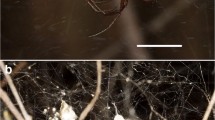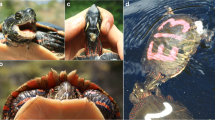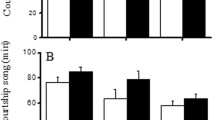Abstract
In the animal kingdom, males typically acquire reproductive access to females through courtship, nuptial gifts, or combat. In many species, small or poor-condition males that are unable to produce an attractive display, proffer an adequate mating gift, or dominate in male–male competition may resort to forced copulation. Forced copulation has been previously demonstrated in the camel cricket Pristoceuthophilus marmoratus and is uniquely facilitated by male hind leg weaponry that functions in both intrasexual competition and sexual coercion. Because male leg armaments are positively allometric, the largest males would seem best equipped to force-copulate, although they might be the most attractive to females, and so least likely to adopt a forced copulation strategy. In order to resolve this potential paradox and determine which males are in fact most likely to force-copulate, we manipulated male body size using diet and performed mating trials. Results showed that (1) male size increased with diet quality, (2) females appear to prefer larger males, and (3) smaller males were more likely to attempt forced copulation. Our results thus suggest that forced copulation is a condition-dependent alternative mating tactic used by small males unattractive to females.





Similar content being viewed by others
References
Alcock J (2009) Animal behavior. Sinauer Associates, Sunderland
Allen GR, Simmons LW (1996) Coercive mating, fluctuating asymmetry and male mating success in the dung fly Sepsis cynipsea. Anim Behav 57:737–741
Andersson M (1994) Sexual selection. Princeton University Press, Princeton
Arnqvist G, Rowe L (2002) Correlated evolution of male and female morphologies in water striders. Evolution 56:936–947
Bohonak AJ, van der Linde K (2004) RMA: Software for Reduced Major Axis regression, Java version. http://www.kimvdlinde.com/professional/rma.html. Accessed 2 Oct 2012
Cade W (1980) Alternative male reproductive behaviors. Fla Entomol 63:30–45
Cheng KM, Burns JT, McKinney F (1982) Forced copulation in captive mallards (Anas platyrhynchos): II. Temporal factors. Anim Behav 30:695–699
Cheng KM, Burns JT, McKinney F (1983) Forced copulation in captive mallards. III. Sperm competition. Auk 100:302–310
Clutton-Brock TH, Parker GA (1995) Sexual coercion in animal societies. Anim Behav 49:1345–1365
Dawkins R (1980) Good strategy or evolutionarily stable strategy? In: Barlow GW, Silverberg J (eds) Sociobiology: beyond nature/nurture. Westview Press, Boulder, pp 331–367
Eberhard WG (1996) Female choice: sexual selection by cryptic female choice. Princeton University Press, Princeton
Evans JP, Pilastro A, Ramnarine IW (2003) Sperm transfer through forced matings and its evolutionary implications in natural guppy (Poecilia reticulata) populations. Biol J Linn Soc 78:605–612
Gray DA, Eckhardt G (2001) Is cricket courtship song condition-dependent? Anim Behav 62:871–877
Haley EL, Gray DA (2012) Mating behavior and dual-purpose armaments in a camel cricket. Ethology 118:49–56
Haley EL, Gray DA (2013) Abdominal tubercles of adult male camel crickets, Pristoceuthophilus marmoratus Rehn (Orthoptera: Rhaphidophoridae), produce cues attractive to females. J Insect Behav 26:804–811
Kokko H (2005) Treat ‘em mean, keep ‘em (sometimes) keen: evolution of female preferences for dominant and coercive males. Evol Ecol 19:123–135
Lehmann GUC, Lehmann AW (2000) Spermatophore characteristics in bushcrickets vary with parasitism and remating interval. Behav Ecol Sociobiol 47:393–399
McKinney F, Derrickson SR, Mineau P (1983) Forced copulation in waterfowl. Behaviour 86:250–294
McLain DK, Pratt AE (1999) The cost of sexual coercion and heterospecific sexual harassment on the fecundity of a host-specific, seed-eating insect (Neacoryphus bicrucis). Behav Ecol Sociobiol 46:164–170
O’Hara JE, Gray DA (2004) Two new Orthopteran hosts of North American Polideini (Diptera: Tachinidae). Entomol News 115:171–172
Patton RL (1967) Oligidic diets for Acheta domesticus (Orthoptera: Gryllidae). Ann Entomol Soc Am 60:1238–1242
Sakaluk SK, Bangert PJ, Eggert AK, Gack C, Swanson LV (1995) The gin trap as device facilitating coercive mating in sagebrush crickets. Proc R Soc Lond B 261:65–77
Stutt AD, Siva-Jothy MT (2001) Traumatic insemination and sexual conflict in the bed bug Cimex lectularius. Proc Natl Acad Sci U S A 98:5683–5687
Thornhill R (1980) Rape in Panorpa scorpionflies and a general rape hypothesis. Anim Behav 28:52–59
Vahed K (1997) Copulation and spermatophores in the Ephippigerinae (Orthoptera: Tettigoniidae): prolonged copulation is associated with a smaller nuptial gift in Uromenus rugosicollis Serville. J Orthopt Res 6:83–89
Vahed K (2002) Coercive copulation in the Alpine Bushcricket Anonconotus alpinus Yersin (Tettigoniidae: Tettigoniinae: Platycleidini). Ethology 108:1065–1075
Vahed K, Carron G (2008) Comparison of forced mating behavior in four taxa of Anonconotus, the Alpine bushcricket. J Zool 276:313–321
Acknowledgments
Funding was provided by grants from the Orthopterists’ Society and the CSUN Office of Graduate Studies and Department of Biology. The late Ted Cohn is especially acknowledged for his assistance, consultation, and enthusiasm.
Author information
Authors and Affiliations
Corresponding author
Additional information
Communicated by S. Sakaluk
Rights and permissions
About this article
Cite this article
Conroy, L.P., Gray, D.A. Forced copulation as a conditional alternative strategy in camel crickets. Behav Ecol Sociobiol 68, 1431–1439 (2014). https://doi.org/10.1007/s00265-014-1750-7
Received:
Revised:
Accepted:
Published:
Issue Date:
DOI: https://doi.org/10.1007/s00265-014-1750-7




